We can't say that Esperance turned the weather on for us, but we have had an enjoyable two night stay in the town that has a population of approximately 14,500. We have stayed at the Seafront Caravan Park, which is a Top Tourist, now GDay park. It is known to be a bit windy here, but we were up the back and the wind was okay. It was just a bit cold and a few spits of rain at times. The Shire actually owns the park and it definitely needs some money spent on it.
European history of the region dates back to 1627 when the Dutch vessel 'Golden Zeepaert' passed through waters off the Esperance coast, continuing across the Great Australian Bight. We've just learnt all about the Dutch explorers in Ceduna and Streaky Bay. The French explorers are credited with making the first landfall near the present day town, naming it and other local landmarks, whilst sheltering from a storm in this area in 1792. The town itself was named after a French ship, 'The Esperance' which is French for 'hope'. In 1802, British navigator Matthew Flinders sailed the Bay of Isles, discovering and naming places such as Lucky Bay. It is said "Whalers, sealers and pirates followed, as did pastoralists and miners, keen to exploit the free land and cash in on the gold boom in the goldfields to the north".
The area of the Esperance townsite was first settled by the Dempsters in 1864, a pioneering family of Scottish descent. There were four Dempster brothers who were granted 304,000 acres of land in the area. They initially brought sheep, cattle and horses overland from Northam, but in 1866 they shipped stock to the Esperance area from South Australia. They built Esperance's first landing. Once other settlers started taking up land on the Esperance coastal plain, a small settlement developed, serving as an important link in the Overland Telegraph between Albany and Eucla. A telegraph station was opened in 1876, although the formal gazette of the townsite did not occur until 1893. The town jetty was also built through the 1890s, following the discovery of gold in the eastern goldfields region. At this point, Esperance became the 'Gateway to the Goldfields'.
We decided to go to Stonehenge first on Saturday morning, but not until we had the washing on the line. Peter had visited this new tourist attraction in 2011, when we were in Esperance for the CWA State Conference. It wasn't quite finished, but he was so impressed he wanted to take me out there for a look, before we went home after the conference. The only thing was we couldn't find it! So we were determined to go this time and of course over the last seven years it has become a popular tourist attraction in the area. It is about 15 kilometres from Esperance and well signed now.
Firstly though a little blurb about Stonehenge in England. This information was on display in the reception area of the Esperance tourism venture. For centuries people have puzzled over Stonehenge. Why did people 5,000 years ago drag 50 ton rocks mile after mile and then place them in a line with the sun on two special days of the year? The Summer Solstice - 22nd June and the Winter Solstice 21st December. There are no texts to explain the ancient site. The reasons can be a multitude of meanings: temple to the sun or moon, astronomical calendar, city of the ancestral dead, centre of healing, stone representations of the Gods, symbol of status and power. Stonehenge was created around 1950BC and fell out of use around 1500BC, and over the centuries many of its stones toppled, broke or were carried off. Casualties of nature as well as man.
In Esperance the Stonehenge construction commenced in January 2011 and was completed on the 26th of October 2011. It is a full-sized replica of the iconic British monument, but the owners Kim and Jillian Beale never originally intended for it to be on their cattle property. The Stonehenge replica is constructed out of 137 massive stones and it was created for a millionaire in Margaret River, but when financial difficulties struck, the local quarry began looking for another buyer. The stones were purchased by the Beale's in 2011 and it has been constructed from 2,500 tonnes of local pink granite. It is said that there is an amazing feeling of calmness when you visit and you can feel the ambiance. The visit did provide a certain aura for us, set high on the hill, with a few cows nearby and great views through to the port of Esperance on a clear day. We were impressed. In 2014 it was placed on the market for $5 million and the owners are looking to put it on the market again. They are hoping to sell and retire. In fact they are thinking of Geraldton as a retirement location.
The 10 Trilithon Stones in the horseshoe pattern weigh between 38 and 50 tonnes each, standing with the 18 tonne lintels (horizontal stones) of 8 metres. Inside the horseshoe stand another horseshoe of 19 blue stones. The Trilithon Stones are surrounded by a circle of 30 Sarsen Stones, each weighing 28 tonnes and standing 5 metres high, including 7 tonne lintels on top. Positioned between the Sarsen Circle and the Trilithon Stones is a full circle of 40 smaller stones, referred to as the Bluestone Circle. The Altar Stone weighs 9 tonne and lies in front of the tallest Trilithon Stones. The structure is aligned with the summer solstice sunrise of Esperance. It must be a beautiful site to see the suns rays on the altar on the 22nd December each year. The finish of the stones has been achieved with a jet burner which is a diesel fueled tool which operates under air pressure from a large compressor. This gives a very hot flame and when applied to the stone face, the surface explodes leaving a more natural finish.
Kim and Jillian have been Esperance residents for 40 years, arriving here in 1972 working on local properties. As new land farmers in 1978, they purchased and cleared 2,500 acres. In 2001 they purchased the property that they have built their Stonehenge on. Developing the property, building all new buildings and infrastructure over the next 10 years, was their semi-retirement plan. Kim said "The building of Stonehenge has been a rewarding experience, but they are ready now for the next stage of their life". As the sign says, a visit is 'A walk back through history, until everything ancient is new again. Still leaving much to the imagination and unexplained'........
We went back into Esperance and checked out the small boat harbour, which is known as the Bandy Creek Harbour. A severe storm in January 2007 caused a great deal of damage to the harbour when the Bandy Creek Weir could not handle the volume of storm water. The harbour was filled with silt and fishing boats left sitting on sand. It was described as a 'once in a lifetime storm'.
We enjoying a short walk along the foreshore before lunch. The upgrade to the 'Foreshore Precinct' was officially opened by the Premier Colin Barnett in June 2014. There was information about the Newtown Jetty and the James Street Jetty. Since the late 1800's there has been controversy about jetties in Esperance. Although nothing remains, the Newtown Jetty served Esperance for nearly 40 years. In the late 1800's, shipping was the best way to get livestock from Esperance to the markets in Adelaide and Albany. In 1894 the Hampton Plains Company built Newtown Jetty, which was where Castletown is today. Although Newtown Jetty was used by many ships, the State Government built and opened the James Street Jetty in 1895. At that time John Forrest was the Premier of W.A. and he issued a ban on loading goods at Newtown Jetty and forbade plans to extend it. Unable to survive under these conditions, it eventually failed and lay idol until late 1896. In 1898 it was extended to allow larger ships to berth. Today only 29 piles remain from the original structure, with some seven cross top beams.
The James Street Jetty was replaced in 1935 and is now referred to as the 'Tanker Jetty'. The length of the jetty was 2,865 feet and the width 48 feet. The depth of water at the seaward end is 36 feet. This jetty has been very much in the news and in June this year another section collapsed. The first section to collapse was in September 2017 and the community has been split on the future of the jetty and how much money should be spent to save it. It is estimated that $40 million would be needed, as that is how much is required for Carnarvon Jetty.
I decided to wander off and go looking for a geocache and it took me to an army tanker beside the RSL building. The building was cute and the information provided about the army tanker, had me searching the internet and even sending Jenny Mac a text. I knew she was in Northampton for the Midwest Chapter Museum meeting and had the opportunity to find out the answer if she didn't know. But of course she did!
The cache took us three visits to find it! It was interesting because Dorothy actually decided to also come looking with me, and when we first looked, there was a couple of guys looking in the spot where it did turn out to be. They were still there when we left, as a RSL man had come and was talking to them. I actually thought more about the use of the word 'Muggle' by geocachers! You have to be discreet so the cache is not 'Muggled', even if it means talking with someone for half an hour, when you would love to be searching!
The story of the army tank is; The Australian Army Leopard ASI Tank was manufactured in Germany and the first major exercises involving the Leopard was at the Woomera range area in S.A. in 1977. The tank was a replacement to the Centurion Tank. In 2011, 29 were delivered to RSL clubs around Australia. The 'Leopards' operated for almost 30 years and the closest they came to action, was when several were loaded (and then quickly unloaded) onto a warship bound for East Timor during the 1999 conflict. The German manufactured 'Leopards' never fired a shot in anger and were replaced in 2007 by 59 second-hand US built M1A1 Abrams tanks.
The Esperance 'Leopard' arrived in the town in April 2011. Five were delivered to Western Australia and the others are at Bunbury, Port Kennedy, Geraldton and the Collie-Cardiff combined RSL branch. When they were delivered to Australia in 1977, the cost was $600,000 each and it has cost the Rudd Government substantial money to honour the pledge of the previous government. Three years after they were promised to RSL clubs around Australia, the 29 Leopard tanks were finally delivered. The three year sticking point was the $22,000 per machine to transport them. So that army tank with it's hidden geocache certainly has a story!
After lunch we took in the scenic coast drive. A visit to Esperance is not complete without doing the 40 kilometre loop that takes you to the Rotary Lookout, Lovers Cove, West Beach, Chapman's Point, Blue Haven, Salmon Beach, Twilight Cove, Dolphin Cove and Observatory Point. There are a few other beaches you can go to on dirt tracks, but we didn't bother doing that. We did stop at the 10 Mile Wind Farm and the Pink Lake Lookout, to look at the lake that is no longer pink, nor the tourist attraction it used to be. All too scientific for me to explain why it is no longer pink, but it has something to do with a decrease in salt concentration, due to salt mining ceasing in 2007 and fresh water entering the system. Increasing salt concentrations, combined with decreasing water levels from evaporation during summer months, trigger the pink hue.
It was a shame the weather wasn't nicer, because the ocean at Esperance is such a magical shade of torquise blue, the beaches can be a bit rocky in places, but the sand is so white and sooo hard. You can actually drive from the Cape Le Grande National Park to the Esperance small boat harbour on the beach.
The sun did come out whilst we were at Observatory Point and we had climbed all those steps to take in the views all around and across to Observatory Island. When the sun came out it was definitely time for a photo shoot. The plaque at Observatory Point, commemorates the arrival on December 9th 1792 of two French ships, the Recherche and the Esperance. The ships sheltered in the lee of Observatory Island immediately offshore from the point. The Esperance Bay Historical Society erected the plaque 200 years later on the 9th December 1972 and it was unveiled by the eldest surviving pioneer of Esperance.
We found another cache at the information area at the Wind Farm lookout. Without hunting for the cache, I'm not convinced we would have found the path to the information panels and the wind turbine. There was so much natural bush and it was in full bloom and really beautiful. The pathway to the main wind turbine and the cache, was a real picture.
The wind turbines in Esperance form two wind farms which are owned and operated by Synergy. The first is called Ten Mile Lagoon and this was the facility surrounding us. It was built in 1993 and has nine 225kw machines. The second wind farm is called Nine Mile Beach and it was built in 2003 and has six larger 600kw machines. Together the wind farms save about 10,000 tonnes of greenhouse gas emissions each year. The turbines operate in parallel with the Esperance gas turbine station. The first wind farm in Australia was built at Salmon Beach here in Esperance as a research facility in 1987. It was decommissioned in 2002. One machine does still stand on the site as a monument and there is another in the town near the foreshore precinct and the museum. The Ten Mile Lagoon wind farm was the first commercial wind farm in Australia. Esperance was chosen for the wind farms because it is remote and windy. The remoteness means that Esperance is not connected to the W.A. main electricity grid. In an average year the wind farms generate 23% of Esperance's electricity.
Once back in Esperance we took a few more touristy photos on the foreshore and called it a day. The weather wasn't getting any better. We decided to get together in the Camp Kitchen with Dennis and Margaret, as we will be all off again tomorrow. In the end the guys
decided the camp kitchen was too small and there were those in tents using it, so we put the table and chairs beside the van and had a drink together. We did have a little protection from the wind, but the cold did eventually force us back to our vans. But not before I was able to get a final photo of the six of us. Esperance weather is unpredictable. It is said "You can experience the four seasons in one day in Esperance". We certainly have had much nicer weather on previous visits. Time now to head to Albany.

 Esperance, Western Australia, Australia
Esperance, Western Australia, Australia
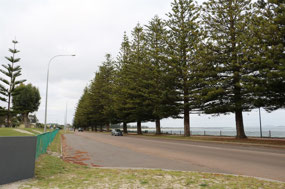


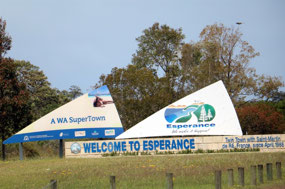
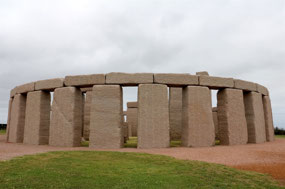
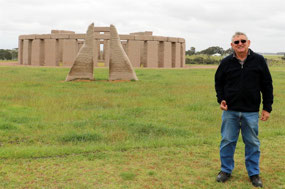

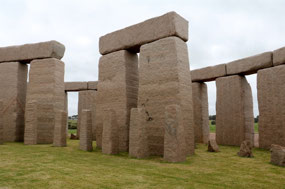
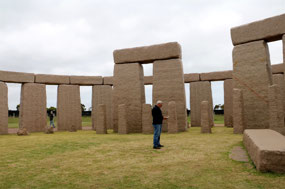
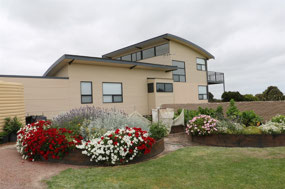
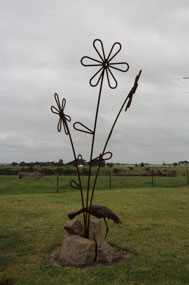

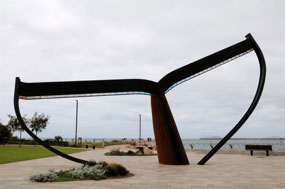
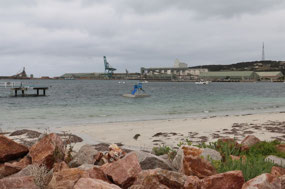
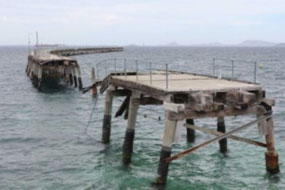
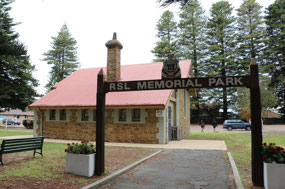
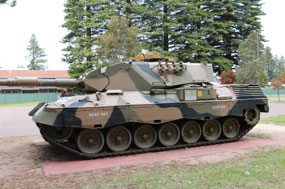
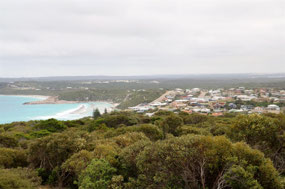
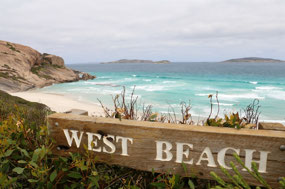
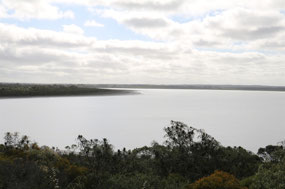
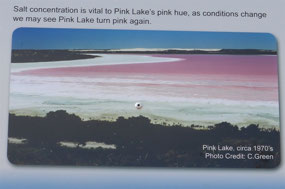
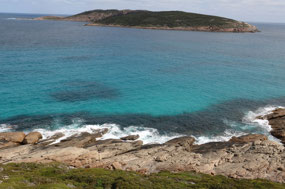

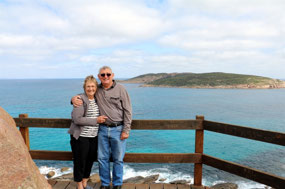
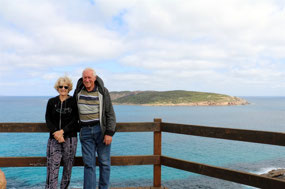
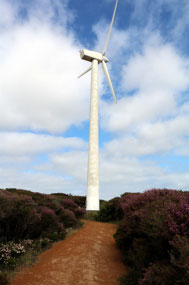
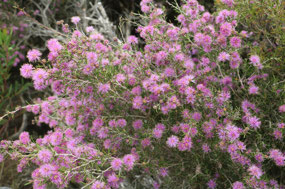
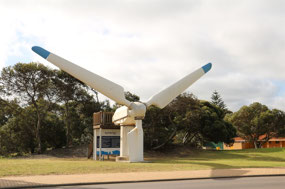
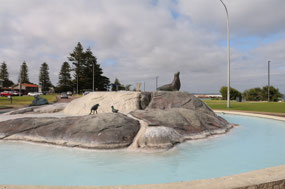
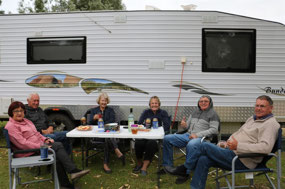

Jenny
2018-11-19
Stonehenge was very interesting and I remember purchasing 2 lovely scarves from the gift shop. The drive around was also scenic, we went both ways. I did respond to your text when it came during the lunch break and was on the spot to get the answer. Interesting story about the tanks. I'm thinking we didn't get that one as tank caches are usually hard to find. Would need to check. There were some Asian tourists at the pink lake which is not so pink, when we were there last year. They'd driven down from Perth just to see it. They asked us when it would turn pink? Tomorrow? Morning? Evening? Sorry, no, best you go to Port Gregory!